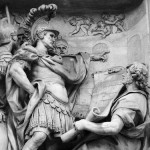We run our website the way we wished the whole internet worked: we provide high quality original content with no ads. We are funded solely by your direct support. Please consider supporting this project.

Jesus, the New Israel
The Gospels present Jesus and the Kingdom he inaugurated as the fulfillment of Israel’s story. For example, Jesus’ birth fulfills Israel’s longing for a Messiah; his return from Egypt as a child mirrors their Exodus out of Egypt; his temptations in the desert allude to Israel’s temptations in the desert; his twelve disciples recall the 12 tribes of Israel; Jesus’ five sets of teachings in Matthew are a parallel of Moses’ Pentateuch; his sufferings fulfill the call of Israel to be a suffering servant, and his resurrection completes the hoped for resurrection of Israel. In sum, the Gospel authors see Jesus as “the appropriate ending” of the story of Israel, as NT Wright notes. Remembering that “Son of God” was a title for Israel as well as of the Messiah, the life, death and resurrection of God’s Son in the Gospels must be understood as “the climax of [Israel’s] election as well as the fullest self-revelation-in-action of the sovereign God.”[1]
All the Gospel authors, but especially Matthew, see various details of Jesus’ life as fulfilling certain details in the OT narrative. While there are a few passages in which it is clear these authors believed Jesus fulfilled something that was predicted in the OT, the vast majority of examples cannot possibly be understood along these lines. They rather reflect the thoroughly Christocentric perspective of these authors on the OT. Here I want to illustrate this point with two examples from Matthew.
Matthew’s Christocentric Interpretation of Rachel’s Weeping. The first example I want to highlight is found in Matthew 2:16-18. Here we read how Matthew interprets the wailing of mothers in Bethlehem after Herod’s massacre to be the fulfillment of parents wailing as they journeyed through Ramah as they were being deported to Babylon. This is a reference back to Jeremiah 31:15. It’s evident that Matthew was not suggesting that the Jeremiah passage predicted the Bethlehem massacre, for there is, in fact, nothing predictive about Jeremiah 31:15. Rather, reflecting an intensely Christocentric focus, Matthew understands the wailing that surrounded the birth of Jesus to be the quintessential expression of the sort of wailing Jewish mothers have often endured at the hands of Gentiles, as expressed in Jeremiah 31:15. If the application strikes us as a stretch, this simply reflects the fact that we don’t share Matthew’s interpretive strategy or the intensity of his Christocentric conviction that the real significance of every passage is the significance it has in the light of Christ.
Matthew’s Christocentric Fusion of Two Texts. The second example is found in Matthew 21:1-5, which narrates Jesus’ entrance into Jerusalem. Here Matthew sees this act as the fulfillment of two awkwardly spliced together verses from Zechariah and Isaiah (Zech. 9:9; Isa 62:11). Matthew is again not suggesting these passages predicted Jesus’ entrance, for there is in fact nothing predictive about either passage. Rather, in Jesus’ royal-yet-humble entrance into Jerusalem, Matthew sees the supreme expression of the sort of king Israel has always longed for, as reflected (in Matthew’s mind) in the two passages he splices together.
Perhaps even more significantly, we should note that the Zechariah portion of the Scripture Jesus “fulfills” in Matthew is taken from the Septuagint. While it’s apparent that the “donkey” and “colt” in the original Hebrew of Zechariah 9:9 is an example of Hebraic parallelism and thus refers to one animal, the translators of the Septuagint for some reason inserted a kia (“and”) between the donkey and colt, thereby rendering them as two different animals. Following this translation, Matthew rewrote Mark’s account (assuming Markan priority) to portray Jesus as somehow riding into Jerusalem on both animals (Mt 21:7). For the same reason Matthew modified Mark’s account of the disciples finding the donkey to include her colt (Mk 11:2-3//Mt 21:3).
From our vantage point, Matthew’s interpretive technique and the unusual depiction of Jesus that results from it can’t help but seem forced, perhaps to the extreme. For some readers, they may also raise questions about the meticulous historical accuracy of Matthew’s portrait and thus about the inspiration of his account. These questions need not detain us presently, however, for our only interest concerns the manner in which Matthew’s interpretation reflects the intensity of his Christocentric convictions.
This just illustrates how everything in Scripture—even, apparently, the insertion of a kia (“and”) in the Septuagint—is assumed to bear witness to Jesus and thus to find its fulfillment in Jesus. Jesus brings God’s dealings with Israel throughout the OT to a climatic fulfillment, and so any aspect of Jesus’ life that in any way has a parallel in the OT is seized by the Gospel writers as “fulfillment” of that parallel.
[1] N.T. Wright, “Christian Origin’s and the Question of God,” in Engaging the Doctrine of God: Contemporary Protestant Perspectives, ed. B. McCormack (Grand Rapids, MI: Baker Academic, 2008), 21-36.
Photo credit: StateofIsrael via VisualHunt / CC BY-SA
Category: General
Tags: Israel, Jesus, Old Testament
Topics: Biblical Interpretation, Christology
Related Reading

Don’t all religions believe in the same God?
http://youtu.be/BKmSr6lKWsk Bruxy Cavey takes a swing at this question and scores a home run.

Xmas
Kevin Dooley via Compfight Zach Hunt brings a huge challenge in this article about the ongoing lament about the “liberal attack on Christmas.” Maybe the real problem is not with the media or the “liberals” or the merchants, but with us. There’s an opportunity here for us to remember who we really are and what…

Seeing and Knowing God
There are many scripture passages that seem to suggest that the way people view God often says more about them than it does about God. Our perception of God, as well as other spiritual truths, is conditioned by the state of our heart. Jesus’ most important teaching on this matter is found in John’s Gospel…

The Cruciform Center Part 4: How Revelation Reveals a Cruciform God
I’ve been arguing that, while everything Jesus did and taught revealed God, the character of the God he reveals is most perfectly expressed by his loving sacrifice on the cross. Our theology and our reading of Scripture should therefore not merely be “Christocentric”: it should be “crucicentric.” My claim, which I will attempt to demonstrate…

Why Didn’t Jesus Denounce Military Service?
A common objection to the claim that Jesus and the authors of the New Testament were opposed to all forms of violence is that neither Jesus nor anyone else speaks out against it. When soldiers asked John the Baptist what they should do in response to his message, for example, he told them not to…

Jesus: Our Vision of God
At the beginning of his Gospel John taught that “no one has ever seen God, but the one and only Son, who is himself God and is in closest relationship with the Father, has made him known” (Jn 1:18). He is claiming that, outside of Christ, no one has ever truly known God. In the…
